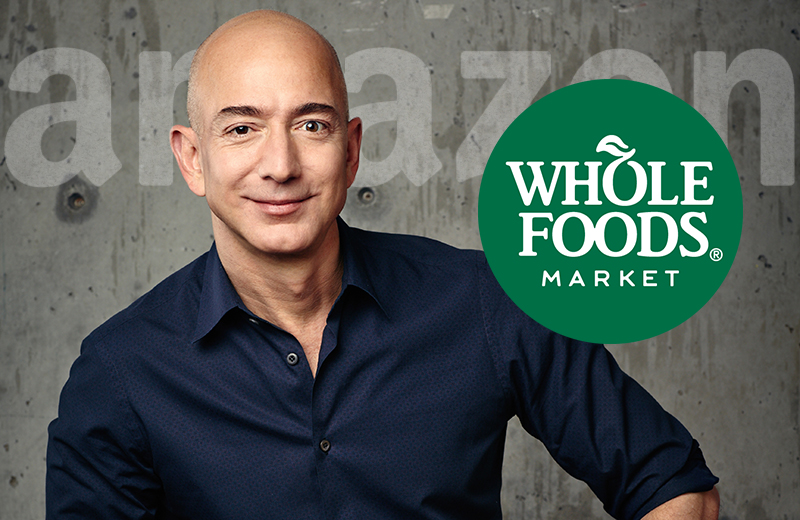By Nicholas Upton
Amazon and whole foods announced a merger agreement where Amazon will buy Whole Foods Market for $42 per share for an all-cash transaction of $13.7 billion. And now rumors are swirling that Grubhub is next.
The Whole Foods acquisition alone signals a massive shift in the retail giant’s strategy and one that makes sense given the brand’s fits and starts in the grocery segment. CNBC’s Jim Cramer called the move a “game changer” that will lead to their domination of food in the next couple years.
“What this says is that Amazon wants to do for food—which they’ve struggled with—what they did with every other part of retail,” said Cramer on CNBC soon after the deal was announced.
More than ever, Cramer’s typical bluster seems fitting. As we’ve covered before, Amazon clearly has been grappling with food for some time with tests like it’s somewhat buggy automated grocery stores and high-cost food delivery plans the giant dialed back from $299 a year to $15 per month.
But with a base of locations, a sophisticated supply chain and incredibly brand equity, Whole Foods will become the middle step between online and offline grocery sales.
And just after the Whole Foods announcement, rumors started swirling about another possible acquisition in the Food On Demand space: Grubhub.
Aaron Turner, an equity analyst at Wedbush, issued a coverage note starting the rumors about an Amazon-Grubhub acquisition. He said given the company’s recent explorations, it’s a sound theory.
“Amazon has already made its own foray into restaurant delivery with minimal success, the overlap between Whole Foods (WFM) customers and Grubhub (GRUB) users likely high due to similar geographic footprint and value propositions, and synergies would likely be realized with GRUB’s operational and logistical infrastructure,” wrote Turner.
It’s largely failed to push the vertical organically, and an acquisition would net the new entity a network of 9 million active diners and 50,000 restaurant partners. It would also “eliminate the need for duplicative delivery infrastructures” wrote Turner.
The company has already been hard at work creating it’s own delivery network to ferry goods including food from local warehouses across the country. Any major metro has seen the fleet of vans zipping around town. But it’s been tricky and expensive—if people are involved, delivery always is. Consolidating delivery to a large group of drivers who can cover a lunch rush as Grubhub drivers then get back to delivering typical Amazon goods could be a game changer for the industry.
The contrarian view, however, is the company track record of small M&A deals that compliment the core business. It acquired Zappos for $1.2 billion in 2012 to grab the shoe market, Kiva Systems in 2012 for $775 million, gobbling up the creator of it’s warehouse robots that cut 20 percent from warehouse expenses.
Amazon did buy streaming platform Twitch for $970 million in 2014, and like Whole Foods didn’t exactly fit the core product, but that was just smart diversification—the platform is reaching a $20 billion valuation. Other acquisitions either powered up the AWS business or took out competition, like Souq.com, the “the Amazon of the Middle East.”
Whole Foods makes sense from a real estate perspective as it completes that “last mile” of food for grocery shoppers, pick up and delivery folks. And it could signal a change in how the company does M&A. It was a big deal even by Amazon standards, so if it does signal that the company is ready to pay for performance—at a projected M&A valuation by Turner of $4.5 billion—it would certainly be a bargain compared to Whole Foods.
Not much is changing for Whole Foods right now or Grubhub (though the latter got a nice bump in it’s stock price from the rumors). John Mackey will continue to operate as CEO of Whole Foods Market and Whole Foods Market’s headquarters will stay in Austin, Texas—a 20 minutes from the nearest Amazon fulfillment center.
“This partnership presents an opportunity to maximize value for Whole Foods Market’s shareholders, while at the same time extending our mission and bringing the highest quality, experience, convenience and innovation to our customers,” said Mackey said in a press release announcing the deal.
But what will certainly change is how fast that innovation comes and how people get food at those locations. Bundling up online orders as Amazon has done in other tests will more than likely get some space in Whole Foods. And consumers will be able to interact with the brand physically, something they have stubbornly shown they want time and time again.
For the rest of the industry, well it’s a time of solemn reflection: a time to grab a cup of tea and look out to the sea. It might not be tomorrow, it might not be within the next 10 years, but Amazon is coming. One just has to look at the brutal big-box retailer culling for a hint at the future.
“They could change the whole business paradigm,” said Cramer. “I struggle to see what this whole industry is going to look like, is everyone just a department store waiting to be eaten alive?”
A look at other grocery stocks out there say, investors are thinking so. Kroger Dropped more than $21 or 13 percent on Friday, Supervalue tanked $3 or 16 percent and even Costco with it’s highly differentiated and cult-like following sank more than 7 percent. Grubhub stock surged nearly 10 percent as rumors swirled.


